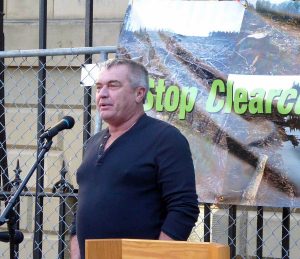UPDATE Mar 17, 2018: Old-growth burning reignites biomass debate
Aaron Bewsick, Chronicle Herald, Mar 17, 2018.
With 84% being burnt via the Biomass Burner (73%) or Firewood (11%), PHP, NSP, NSDNR ad even FSC are doing their part to increase GHG emissions while calling the practices “sustainable”.
——————————–
In reference to Danny George’s claim that Old Growth forest is being cut on Crown land in the Loon Lake area (see Post, Feb 23, 2018), Nova Scotia Department of Natural Resources used some very cautious language in response to queries from the Chronicle Herald and managed to avoid any admission that their system for managing harvests of Crown land forests is seriously flawed.
From VIDEO: Province admits old-growth forest may have been cut for fuel
(Aaron Beswick in the Chronicle Herald, March 15, 2018):
“We acknowledge the possibility of old forest or old growth in there,” said Mark Pulsifer, regional resource manager for the Department of Natural Resources.
…“When we have those situations where there are errors, our fall-back is that we have boots on the ground,” he said.
…“I am confident today that if the same people were going to go back in today, they would be able to identify (the potential for old growth).”
…Asked if the department considered cutting old-growth forest to be acceptable, he said, “It can be, depending on where we are.”
Pulsifer said that because the province has already protected about 16 per cent of the land in that particular ecodistrict as old forest — above the required eight per cent — the department is able to allow some cutting in areas that could qualify as old forest.
The Chronicle Herald article includes a video with Danny George at one of the sites for which DNR acknowledges “the possibility of old forest or old growth in there.”
As it’s almost 2 weeks since NSDNR said the Rocky Lake site was being assessed by their old forest specialist, I am guessing NSDNR now knows more about than site than they are letting on; they are just trying to figure out how to phrase it all.
In the meantime, Port Hawkesbury Paper is not about to accept any responsibility in the matter:
Marven Hudson, district superintendent for Port Hawkesbury Paper, said identifying old growth is the province’s responsibility, not the mill’s.
“We don’t identify the old growth — the province identifies old growth,” he said.
“We put our (pre-treatment assessments) into that program and it spits out what treatment we should do.”
I have to wonder, as I have before, what FSC certification of PHP’s Crown land management does that is not covered by DNR requirements. Certainly, the public has higher expectations.
Danny George had also said that the harvested wood was going to the Port Hawkesbury biomass burner, rather than being directed to high value products reflecting the real value of the wood. PHP apparently responded to the Chronicle Herald on that score:
According to a document provided by Port Hawkesbury Paper, of the hardwood it has cut in the area of Loon Lake Road, 73 per cent went for fuel wood (biomass), 11 per cent for firewood, eight per cent for hardwood pulp, six per cent for saw logs and a very small amount to make pallets.
This statement doesn’t quite square with a previous statement by PHP:
Related to fuel for the Nova Scotia Power boiler, PHP’s supply comes mostly from wood bark removed by mills prior to lumber or paper production. The supply of low-grade fuelwood to the boiler (such as those harvested on the Loon Lake site) follows the allocation of higher quality material (sawlogs, studwood, or pulpwood) which is directed to wood processing facilities for primarily lumber and paper production. It would not make economic sense to send higher quality material to the biomass facility because the economic value would not be fully realized. With the available supply of wood bark and low-grade fuelwood, there is no need to allocate higher valued material to the biomass facility.
View previous posts related to harvests in the Loon Lake area.
———-
Thanks for the straight talk, Danny George and Thanks to the Chronicle Herald/Aaron Beswick for checking it all out

